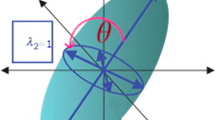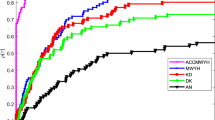Abstract
Computer vision often involves estimating models from visual input. Sometimes it is possible to fit several different models or hypotheses to a set of data, and a decision must be made as to which is most appropriate. This paper explores ways of automating the model selection process with specific emphasis on the least squares problem of fitting manifolds (in particular algebraic varieties e.g. lines, algebraic curves, planes etc.) to data points, illustrated with respect to epipolar geometry. The approach is Bayesian and the contribution three fold, first a new Bayesian description of the problem is laid out that supersedes the author's previous maximum likelihood formulations, this formulation will reveal some hidden elements of the problem. Second an algorithm, ‘MAPSAC’, is provided to obtain the robust MAP estimate of an arbitrary manifold. Third, a Bayesian model selection paradigm is proposed, the Bayesian formulation of the manifoldfitting problem uncovers an elegant solution to this problem, for which a new method ‘GRIC’ for approximating the posterior probability of each putative model is derived. This approximations bears some similarity to the penalized likelihoods used by AIC, BIC and MDL however it is far more accurate in situations involving large numbers of latent variables whose number increases with the data. This will be empirically and theoretically demonstrated.
Similar content being viewed by others
References
Akaike, H. 1974. A new look at the statistical model identification. IEEE Trans. on Automatic Control, AC-19(6):716–723.
Akaike, H. 1985. Prediction and entropy. In A Celebration of Statistics. The ISI Centenary Volume, A.C. Atkinson and S.E. Feinberg (Eds.). Springer: New York, pp. 1–24.
Arnborg, S. and Sjödin, G. 2000. Bayes rules in finite models. In European Conference on Artifical Intelligence, pp. 571–575. Also available at ftp://ftp.nada.kth.se/pub/documents/ Theory/Stefan-Arnborg/ fobcl.pdf.
Beardsley, P., Torr, P.H.S., and Zisserman, A. 1996. 3D model acquisition from extended image sequences. In Proc. 4th European Conference on Computer Vision, Cambridge,B. Buxton and Cipolla R. (Eds.). LNCS 1065, Springer-Verlag: Berlin, pp. 683–695.
Belhumeur, P.N. and Mumford, D. 1992. A Bayesian treatment of the stereo correspondence problem using half-occluded regions. In IEEE Comp. Soc. Conf. on Comp. Vision and Pattern Recognition, pp. 506–512.
Bernardo, J.M. and Smith, A.F.M. 1994. Bayesian Theory. Wiley: Chichester.
Besag, J. 1974. Spatial interaction and statistical analysis of lattice systems. J. Roy. Stat. Soc. Lond. B., 36:192–225.
Bishop, C.M. 1995. Neural Networks for Pattern Recognition. Clarendon Press: Oxford.
Blake, A. and Zisserman, A. 1987. Visual Reconstruction. MIT Press: Cambridge, USA.
Bozdogan, H. 1987. Model selection and Akaike's information criterion (AIC): The general theory and its analytical extensions. Psychometrika, 52(3):345–370.
Chickering, D. and Heckerman, D. 1996. Efficient approximation for the marginal likelihood of bayesian networks with hidden variables. Microsoft, Technical Report msr-tr-96-08.
Cox, R.T. 1946. Probability, frequency, and reasonable expectation. Am. Jour. Phys., 14:1–13.
Cox, R.T. 1961. The Algebra of Probable Inference. John Hopkins Univ. Press: Baltimore.
Csurka, G., Zeller, C., Zhang, Z., and Faugeras, O. 1996. Characterizing the uncertainty of the fundamental matrix. CVIU, 68(1):18–36.
Dawid, A.P. 1992. Prequential analysis, stochastic complexity and bayesian inference. In Bayesian Statistics 4, pp. 109–125.
Efron, B. and Tibshirani, R.J. 1993. An Introduction to the Bootstrap. Chapman and Hall: London, UK.
Faugeras, O.D. 1992. What can be seen in three dimensions with an uncalibrated stereo rig? In Proc. 2nd European Conference on Computer Vision, Santa Margherita Ligure, G. Sandini (Ed.). LNCS 588, Springer-Verlag, pp. 563–578.
Faugeras, O.D. 1993. Three-Dimensional Computer Vision: A Geometric Viewpoint. The MIT Press: Cambridge, MA.
Faugeras, O. and Papadopoulo, T. 1993. A theory of the motion fields of curves. Int. J. Computer Vision, 10(2):125–156.
Fischler, M.A. and Bolles, R.C. 1981. Random sample consensus: A paradigm for model fitting with application to image analysis and automated cartography. Commun. Assoc. Comp. Mach., 24:381–395.
Fitzgibbon, A. 1997. Stable segmentation of 2D curves. Ph.D. Thesis, Edinburgh. Available at http://www.robots.ox.ac.uk/awf/.
Gauss, C.F. 1821. Theoria combinations observationum erroribus minimis obnoxiae. Werke4, Section35, Gõttingen.
Gelman, A., Carlin, J.B., Stern, H.S., and Rubin, D.B. 1995. Bayesian Data Analysis. Chapman &; Hall: New York.
Geman, S. and Geman, D. 1984. Stochastic relaxation, Gibbs distributions, and the Bayesian restoration of images. IEEE Trans. on Pattern Analysis and Machine Intelligence, 6(6):721–741.
Golub, G.H. and van Loan, C.F. 1989. Matrix Computations. Johns Hopkins.
Grenander, U., Chow, Y., and Keenan, D.M. 1991. HANDS. A Pattern Theoretical Study of Biological Shapes. Springer-Verlag: New York.
Gull, S.F. 1989. Bayesian data analysis: Straight line fitting. In Maximum Entropy and Bayesian Methods. Kluwer: Dordrecht.
Harris, C. 1990. Structure from motion under orthographic projection. In Proc. 1st European Conf. Computer Vision, O. Faugeras, (Eds.). Springer-Verlag: Berlin, pp. 118–123.
Hartley, R. and Zisserman, A. 2000. Multiple View Geometry in Computer Vision. Cambridge University Press.
Hartley, R.I. 1992. Estimation of relative camera positions for uncalibrated cameras. In Proc. 2nd European Conference on Computer Vision, Santa Margherita Ligure, G. Sandini (Eds.). LNCS 588, Springer-Verlag: Berlin, pp. 579–587.
Hartley, R.I. and Sturm, P. 1994. Triangulation. In DARPA Image Understanding Workshop, Monterey, CA, pp. 957–966.
Hjorth, U. 1989. On model selection in the computer age. J. Statist. Planng. Inf., 23:101–115.
Irani, M., Anandan, P., and Weinshall, D. 1998. From reference frames to reference planes: Multiview parallax geometry and its applications. In Proc. 5th European Conference on Computer Vision, Freiburg, H. Burkhardt and B. Neumann (Eds.). LNCS 1406, Springer-Verlag: Berlin, pp. 829–846.
Isard, M.A. and Blake, A. 1996. Visual tracking by stochastic propagation of conditional density. In Proc. 4th European Conf. Computer Vision, Cambridge, England, pp. 343–356.
Jaynes, E.T. 1991. Straight line fitting—A bayesian solution. Available at http://bayes.wustl.edu/etj/node2.html.
Jaynes, E.T. 1999. Probability Theory as Extended Logic. Not yet published, a postscript version of this excellent book is available at http://bayes.wustl.edu/etj/node2.html.
Jeffreys, H. 1932. An alternative to the rejection of observations. Proc. Roy. Soc. London A, 137:78–87.
Jeffreys, H. 1939. Theory of Probability. Clarendon Press: Oxford.
Kanatani, K. 1987. What is the geometric AIC? Reply to my reviewers. unpublished report.
Kanatani, K. 1992. Geometric Computation for Machine Vision. Oxford University Press: Oxford.
Kanatani, K. 1994. Statistical bias of conic fitting and renormalization. IEEE Trans. Pattern Analysis and Machine Intelligence, 16(3):320–326.
Kanatani, K. 1996. Statistical Optimization for Geometric Computation: Theory and Practice. Elsevier Science: Amsterdam.
Kass, R.E. and Raftery, A.E. 1995. Bayes factors. Journal of the American Statistical Association, 90:733–795.
Kendall, M.G. and Moran, P.A.P. 1963. Geometric Probability. Hafner: New York.
Kendall, M.G. and Stuart, A. 1983. The Advanced Theory of Statistics. Charles Griffin and Company: London.
Leontaritis, I.J. and Billings, S.A. 1987. Model selection and validation methods for non-linear systems. Int. J. Control, 45(1):311–341.
Li, M. and Vitányi, P. 1997. An Introduction to Kolmogorov Complexity and its Applications. Springer-Verlag: Berlin.
Lindley, D.V. 1980. Approximate Bayesian methods. In Bayesian Statistics, J.M. Bernardo, M.H. DeGroot, D.V. Lindley, and A.F.M. Smith (Eds.). Valencia University Press: Valencia, pp. 223–237.
MacKay, D.J.C. 1992. Bayesian Interpolation. Neural Computation, 4:415–447.
Mallows, C.L. 1973. Some comments on c p . Technometric, 15:661–675.
Maybank, S.J. and Sturm, P.F. 1999. MDL, collineations and the fundamental matrix. In BMVC, pp. 53–62.
McLachlan, G.I. and Basford, K. 1988. Mixture Models: Inference and Applications to Clustering. Marcel Dekker: New York.
Miller, A.J. 1984. Selection of subsets of regression variables (with discussion). Journal of the Royal Statistical Society (Series A), 147:389–425.
Miller, A.J. 1990. Subset Selection in Regression. Chapman and Hall: London.
Mundy, J.L. and Zisserman, A. 1992. Geometric Invariance in Computer Vision. MIT Press: Cambridge, MA.
Pearson, K. 1901. On lines and planes of closest fit to systems of points in space. Philos. Mag. Ser., 6(2):559.
Pollefreys, M., Verbiest, F., and Van Gool, L. 2002. Surviving dominant planes in uncalibrated structure and motion recovery, vol. 1.
Riggs, D., Guarnieri, J., and Addelman, S. 1978. Fitting straight lines when both variables are subject to errors. Life Sciences, 22:1305–1360.
Ripley, B.D. 1996. Pattern Recognition and Neural Networks. Cambridge: Cambridge, UK.
Rissanen, J. 1978. Modeling by shortest data description. Automatica, 14:465–471.
Russell, B. 1961. History of Western Philosophy. Routledge.
Santalo, L. 1976. Integral Geometry and Probability. Addison-Wesley: Reading, MA.
Schwarz, G. 1978. Estimating dimension of a model. Ann. Stat., 6:461–464.
Shapiro, L.S. 1993. Affine analysis of image sequences. Ph.D. Thesis, Oxford University.
Stewart, C.V. 1997. Bias in robust estimation caused by discontinuities and multiple structures. IEEE Trans. on Pattern Analysis and Machine Intelligence, 19(8):818–833.
Stone, M. 1977. An asymptotic equivalence of choice of model by cross-validation and Akaike's criterion. J. Roy. Statist. Soc. B, 39:44–47.
Szeliski, R. 1990. Bayesian modelling of uncertainty in low-level vision. Int. J. Computer Vision, 5(3):271–301.
Torr, P.H.S. 1995. Outlier detection and motion segmentation. Ph.D. Thesis, Department of Engineering Science, University of Oxford.
Torr, P.H.S. 1998a. Geometric motion segmentation and model selection. In Philosopical Transactions of the Royal Society A, J. Lasenby, A. Zisserman, R. Cipolla, and H. Longuet-Higgins (Eds.). Roy Soc,: London, pp. 1321–1340.
Torr, P.H.S. 1998b. Selecting model selection paradigms. In D. Fosyth and R. Cipolla (Eds.). Workshop on Shape, Contour and Grouping, pp. 69–113, 1998.
Torr, P.H.S. 2000. In Data Segmentation and Model Selection for Computer Vision. Model selection for structure and motion recovery from multiple images. Springer-Verlag: Berlin, pp. 143–182.
Torr, P.H.S., Beardsley, P.A., and Murray, D.W. 1994. Robust vision. In Proc. 5th British Machine Vision Conference, York, J. Illingworth (Ed.). BMVA Press, pp. 145–155.
Torr, P.H.S., Fitzgibbon, A., and Zisserman, A. 1998a. Maintaining multiple motion model hypotheses through many views to recover matching and structure. In ICCV6, U Desai (Eds.). Narosa Publishing House, pp. 485–492.
Torr, P.H.S., Fitzgibbon, A., and Zisserman, A. 1999. The problem of degeneracy in structure and motion recovery from uncalibrated image sequences. IJCV, 32(1):27–45. Marr Prize Paper ICCV 1999.
Torr, P.H.S. and Murray, D.W. 1997. The development and com-parison of robust methods for estimating the fundamental matrix. Int. Journal of Computer Vision, 24(3):271–300.
Torr, P.H.S. and Zisserman, A. 1997. Robust parameterization and computation of the trifocal tensor. Image and Vision Computing, 15:591–607.
Torr, P.H.S. and Zisserman, A. 1998a. Concerning Bayesian motion segmentation, model averaging, matching and the trifocal tensor. In ECCV98, Vol. 1, H. Burkharddt and B. Neumann (Eds.). Springer: Berlin, pp. 511–528.
Torr, P.H.S. and Zisserman, A. 1998b. Robust computation and parametrization of multiple view relations. In ICCV6, U Desai (Ed.). Narosa Publishing House, pp. 727–732.
Torr, P.H.S. and Zisserman, A. 2000. MLESAC: A new robust estimator with application to estimating image geometry. CVIU, 78(1):138–156.
Torr, P.H.S., Zisserman, A., and Maybank, S. 1998b. Robust de-tection of degenerate configurations for the fundamental matrix. CVIU, 71(3):312–333.
Triggs, B. 1998. The geometry and matching of curves in multiple views. In ECCV98, vol. 1, H. Burkharddt and B. Neumann (Eds.). Springer: Berlin, pp. 89–105.
Triggs, W. 1995. The geometry of projective reconstruction I: Matching constraints and the joint image. In Proc. 5th Int'l Conf. on Computer Vision, Boston, pp. 338–343.
Vapnik, V. 1995. The Nature of Statistical Learning Theory. Springer: New York.
Wallace, C.S. and Boulton, D.M. 1968. An information measure for classification. Computer Journal, 11(2):195–209.
Weiss, Y. 1997. Smoothness in layers: Motion segmentation using nonparametric mixture estimation. In CVPR. IEEE, pp. 520–526.
Weisstein, E. 2002. Maths encyclopedia. http://mathworld. wol-fram. com/.
Werman, M. and Keren, D. 2001. A Bayesian method for fitting parametric and nonparametric model to noisy data. IEEE PAMI, 23(5):528–534.
Wild, G.A.F. and Seber, C.J. 1989. Non-Linear Regression. Wiley: New York.
Zellner, A. 1971. An Introduction to Bayesian Inference in Economics. Wiley: New York.
Zellner, A. 1978. Jeffreys-Bayes posterior odds ratio and the akaike information criterion for discriminating between models. Economics Letters, 1:337–442.
Zhang, Z. 1997a. Determining the epipolar geometry and its uncertainty: A review. IJCV, 27(2):161–195.
Zhang, Z. 1997b. Parameter estimation techniques: A tutorial with application to conic fitting. IVC, 15(1):59–76.
Author information
Authors and Affiliations
Rights and permissions
About this article
Cite this article
Torr, P. Bayesian Model Estimation and Selection for Epipolar Geometry and Generic Manifold Fitting. International Journal of Computer Vision 50, 35–61 (2002). https://doi.org/10.1023/A:1020224303087
Issue Date:
DOI: https://doi.org/10.1023/A:1020224303087




